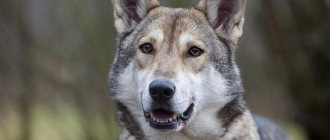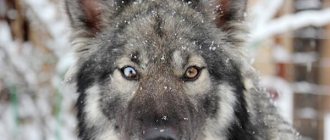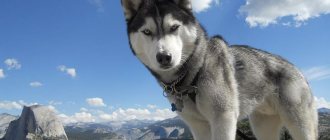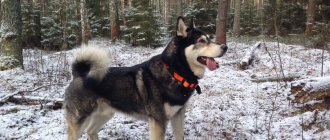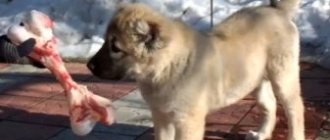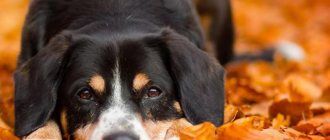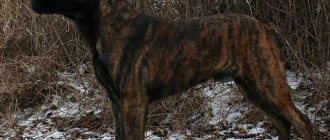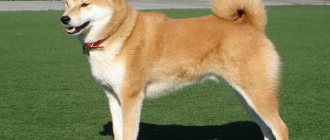This dog appeared in the Netherlands in 1925 after crossing a purebred German Shepherd with a wolf. Lander Sarlos was involved in breeding the breed, and after his death the business was continued by his wife and daughter.
The Saarloos wolfdog mainly lives in its homeland - the Netherlands. It is little known in other countries. Today it is successfully used as a guide for people deprived of vision, for work in extreme search and rescue operations.
Probably, the wide distribution of these animals is hampered by wolf instincts of behavior. This dog lives according to the laws of the pack. Its owner is the leader. What’s surprising is that you don’t need to prove this to the dog in any way. She accepts this situation as a given.
The Saarloos wolf dog, a photo of which we posted in our article, usually keeps its distance from people it doesn’t know and avoids everything that seems suspicious to it.
History of the breed
As already mentioned, L. Sarlos, a citizen of the Netherlands, began breeding this breed. He devoted 39 years of his life to this work. He began conducting his first experiments in 1925, trying to get a shepherd dog that would be endowed with features close to natural ones. He crossed wolves with German shepherds and selected the most desirable colors, in his opinion.
The breeder's task was to obtain the most hardy and strong dogs, without obvious signs of degeneration. In the selection work to develop the breed, Sarlos was helped by his close friend, Dr. A. Hagedorn. The first experiment (1925) did not give the desired result. Wolf's blood was used again only in 1962.
After the death of Lander Sarlos, his wife and daughter continued to improve the breed. A few years later she was officially recognized by the Dutch kennel club. In 1981, the wolfdog was registered with the FCI.
Character of the Czechoslovakian Wolfdog
Thanks to competent selection work, wolfdogs did not turn into ferocious brutals with the habits of forest predators. Moreover, they absorbed only the best qualities of their wild ancestors - amazing endurance, heightened intuition, high intellectual indicators. However, living side by side with a representative of this breed imposes a number of obligations and is in many ways different from coexistence with a German shepherd. As an example: Czechoslovakian wolfdogs have phenomenal suspicion, and alertness and readiness to repel an attack extend to any strangers. Accordingly, if a new family member has appeared in the house, the animal will not be able to overcome the feeling of mistrust towards him soon.
I'm a woolly wolf! God, how good I am, how powerful my paws are!
The Czechoslovakian Wolfdog is selflessly devoted to its owner. However, it should be clarified here: the pet will adore the person who proved his worth and did not allow the animal to “steer” the situation. If there are other “tails” in the house, the wolfdog will definitely try to climb to the top of the hierarchical pyramid in order to command from there everyone who allows himself to be subjugated. The dog will even try to turn small pets into prey if it is not stopped in time, so there is definitely no place for guinea pigs and domestic rabbits in the same territory as the Czechoslovakian wolfdog.
In addition, this is one of the breeds whose representatives are not particularly fond of children. A child, in the understanding of a wolf dog, is a creature at a higher level of development than a cat, but much lower in level than an adult. Having a Czechoslovakian wolfdog in a family with small children is an unjustified risk, especially if the relationship between the children and the pet is not controlled by adults. Remember that representatives of this family react extremely painfully to disrespectful attitude from children. So if a descendant of the Carpathian wolf lives in the house, explain to your children that hugging, pulling the tail and riding a lying pet can result not only in torn shoes, but also in a trip to the emergency room.
Today's Czechoslovakian Wolfdogs are all-round dogs, capable of guarding a home, repelling an attacking intruder, and setting the tone in agility. True, in order for all the listed skills to “work” correctly, instincts alone are not enough - professional training is necessary. Ordinary dog pranks are also not alien to animals. And since Czechoslovakian Wolfdogs are intellectually ahead of most breeds, their pranks are more thoughtful. For example, teenage dogs masterfully open the doors of kitchen cabinets and gates, masterfully steal food, and also seep into any openings that do not correspond to their dimensions.
Description of the breed
Many experts consider the main advantage of this dog to be its somewhat rustic, often wild appearance. A luxurious “wolf head” with a slightly elongated muzzle, triangular, high-set ears, slightly slanted, but very attentive amber eyes - you must agree, such a wolf dog can attract attention. This beauty, with muscular and slightly dry limbs, really does look a lot like a wolf - well-developed, well-groomed, ready for long treks, and with great running speed.
The wolf dog moves as easily as its wild ancestor - widely and smoothly. A strong animal easily moves from one running pace to another.
The height at the withers of males reaches 75 cm, females are slightly lower (70 cm). Weight no more than 41 kg.
Nutrition
When it comes to nutrition, Saarloos's dog is extremely unpretentious. You just need to ensure the necessary balance of the diet, which should first of all contain a sufficient amount of protein. The meat can be anything: beef, veal, chicken, turkey, fish.
For Saarloos wolfdog puppies at an early age, it is better to boil the meat for a short time. Adults, thanks to their wolf nature, can perfectly digest it in its raw form. The diet should also contain a protein component, which can be obtained from buckwheat, rice, and oatmeal. Adding a small amount of vegetables and fermented milk products to the menu will also be useful.
Fresh water should always be within reach. It is better to place the bowls at the dog’s chest level and teach the animal to feed at the same time without the possibility of snacking.
Coat
The Saarloos wolf dog, a photo of which can be seen in some cynological publications, has an original coat that can change depending on the season.
In winter, the animal develops a thick undercoat. Together with the guard hair, a layer of fur is formed on the dog’s body, and a thick collar is formed on the neck.
In the spring-summer season, the guard hair becomes the main one. In the autumn-winter period, air temperature can affect the presence of undercoat, but it is important that there is always a tendency for its appearance.
Character of a bear dog
The Karelian bear husky has a congenital sanguine (easily excitable with a strong inhibition process) or choleric (highly excitable with weak inhibition) type of nervous system.
Dogs with this temperament are courageous, energetic, and easily adapt to unfavorable conditions. They quickly develop and strengthen conditioned reflexes, but often they lack endurance. Distinctive character traits of dogs include stubbornness and a tendency to self-will.
A genetically inherent quality is viciousness towards prey, which often manifests itself towards other dogs and pets.
The Karelian bear husky has a congenital sanguine or choleric type of nervous system.
The dog tries to distance itself from strangers, but does not show aggression. It shows weak guard qualities. At the same time, bear huskies are devoted to their owner, ready to protect him from an animal or other danger, selfless and fearless.
Training and education
When purchasing a bear husky, you should take into account that during the formation of the breed, preference was given to working hunting qualities, therefore keeping them as a family dog or guard is not acceptable for them. The course of protective guard duty is contraindicated for bear cubs, as this provokes manifestations of malice.
When training a bear dog, rigor, even harshness, is required.
The owner is required to have experience in training, developing genetically endowed hunting abilities, and regularly taking the dog “to work.” When teaching, rigor, even rigidity, is required. The use of physical force is possible only in the most extreme cases of aggression and disobedience.
Raising a puppy begins with strengthening the natural inclinations necessary for fishing activities.
Bear cubs need socialization. For villagers, this is, first of all, developing tolerance towards domestic animals. When keeping a dog in an urban environment, you should accustom the puppy to a leash and muzzle.
Training of bear cubs is possible only by the owner or under his constant supervision. Boarding training is not effective.
To develop hunting qualities, it is important:
- clear interaction with the owner;
- strict reinforcement of actions after the command;
- fixation of basic commands: “Come to me!”, “Forward!”, “Back!”, “You can’t!”;
- reaction to the owner’s intonation;
- accustoming to the sound of a gunshot, irritating and distracting factors;
- development of search skills;
- training of the orienting instinct;
- learning to differentiate a trace;
- clear reinforcement of the “No!” command, especially with the prospect of using a dog in hunting fur-bearing animals;
- aportation.
It is optimal to start grooming and baiting a bear husky at the age of 7 months to a year. During this period, it is worth deciding on the dog’s specialization: large ungulates, bear, fur-bearing animals, upland or swamp game.
There are known precedents for female bear cubs participating in agility competitions. But the main purpose of the Karelian bear dog is hunting.
The purpose of the breed is hunting
Hunting with a Karelian bear dog is somewhat different from hunting with other huskies. The breed is considered universal, the dog works on elk, wild boar, bison, roe deer, bear, wolf, lynx, fur-bearing animals, and birds.
Bear dogs are less careful than other representatives of huskies and come close to the animal, so the mortality rate during hunting is high.
It is believed that due to the excessive aggressiveness of bear cubs, they do not hunt in pairs or in packs. However, numerous reviews from hunters indicate that CCMs are able to work successfully in pairs with representatives of their own breed or with other huskies.
Bear dogs are hardy, follow the scent and drive the animal in any weather conditions. They selflessly hold the beast until the shot is fired.
They are less careful than other representatives of huskies and come close to the animal, so the mortality rate of bear cubs during hunting is high.
Character
Saarlos's dog has the temperament of a wolf, tempered by a German shepherd. This is an animal that quickly runs wild, it is unbalanced and prone to wandering. From the wolf she inherited hunting instincts - dexterity when hunting small game. The dog needs space and daily serious physical activity. Thanks to her luxurious “fur coat,” she can live outside at any time of the year.
The wolf dog is an independent creature, but at the same time it is very attached to people. This combination of qualities often makes learning difficult.
Wary behavior towards strangers is not caused by timidity or fear. The wolf dog, photos of which can be seen on the websites of famous kennels, is careful and keeps a distance that allows it to retreat when a threat appears. This is typical wolf behavior. However, she never shows unjustified aggression.
Living and maintenance conditions
The description of the English Cocker Spaniel breed speaks of the medium size of the dog, which allows it to be kept in an apartment. We will discuss the features of caring for it, taking into account the character of the eared pet, below.
Care
The place for the dog should be located away from heating devices and passages with drafts. It is not recommended to purchase newfangled baskets with high sides; the puppy simply will not be able to climb up there.
This can be a soft and warm bedding made from natural materials. Babies do not tolerate loneliness well, they get bored and cry - if you do not want your dog to be left with psychological trauma, do not leave the little one alone for a long time.
It is advisable to remove electrical wires from his field of vision: like all children, he is curious, and trouble is not far away.
Buy him several toys, soft and rubber; choose natural, non-allergenic materials.
Wool and proper haircut
Spaniels have thick, long hair that is prone to tangling and matting. To care for it, you need a thick massage-type brush with natural bristles.
At six months of age, shedding begins - it is important to remove fluff so that it does not interfere with hair growth
Hair also grows on the paws between the pads, which needs to be trimmed, otherwise during a walk all sorts of plant and other debris will cling to it. Worst of all, if anything sharp in it cuts the skin, an infection may occur.
When cutting fur, purchase safety scissors with round tips. Let the puppy get used to their sound, so that in the future the procedure will proceed smoothly, without incidents.
As for fur allergies, numerous studies have found that there are no completely hypoallergenic dogs - if the irritants are not in the fur, they may be in the dog's saliva.
Scientists from the French Academy "Aix-Marseille", which deals with health issues, conducted studies on the presence of allergens in dog hair. The research involved 288 dogs of different breeds and both sexes.
During the experiments, it was found that the lowest coefficient of allergens was found in Labradors, retrievers, spaniels and cocker spaniels.
Ears, eyes, teeth, claws
Long and fluffy ears require especially careful care. They need to be checked after a walk and regularly cleaned of wax accumulation using cotton pads and swabs. Be careful not to damage the delicate skin of the ear canal.
For long-eared pets, it is advisable to purchase plates on a stand so that their ears do not get into the food.
Use special pharmaceutical drops to wipe the pet's eyes, each separately, to avoid infection.
Twice a week you need to brush your teeth with special brushes and toothpastes (available at any veterinary pharmacy or pet store). The color of healthy gums is pink. If the gums are swollen, pale or red, and there is a stench coming from the mouth, the dog should be taken to the veterinarian.
To care for your claws, purchase a special nail clipper and nail file. Cut off what extends beyond the surface of the pad as it grows. To prevent the dog from injuring itself, the edges of the cut are filed.
Bathing
How often you bathe your pet depends on its behavior on the street: if it gets dirty in a puddle or in something “pleasantly” smelling, water treatments with dog shampoo cannot be avoided. In general, there is no need for frequent bathing, and paws should be washed after every walk.
Walks
Ideally, you should walk your pet three times a day. Please note that your pet will relieve itself literally every ten minutes, since their bladder does not empty immediately.
If the walk is intense - with running, games, training exercises - then an hour in one session is enough. You should not put overalls or blankets on your dog; they have quite thick fur.
Nutrition
When feeding with ready-made food, choose dry, semi-dry food and canned food.
You need to choose well-known brands, because, caring about their reputation, in nutrition they take into account everything that is necessary for the development, growth and health of the animal.
Important! It is recommended to eat three meals a day in small portions: this way the pet will never be hungry, since the digestion process in dogs lasts about eight hours. This approach to feeding will not make the dog want to pick up all sorts of nasty things on a walk.
If you decide to feed natural products, then the diet should include:
- boiled meat, preferably lean; chopped vegetables or dried fruits are added to the meat;
- among dairy products, cottage cheese, yogurt and kefir are preferable, but in small quantities to avoid indigestion;
- eggs, either boiled or raw;
- porridge: rolled oats, rice, millet, buckwheat;
- meat by-products - only in boiled form.
Features of education
Socialization and training of this animal must begin from the moment puppies appear in the house. From an early age, a wolf dog must get used to its surroundings and its new owners. If a puppy is afraid of something, the owner should not show sympathy for him - this will only make the situation worse. It is necessary to remain calm - this will convince the baby of safety and help to gain confidence in his abilities.
If there is not just one Saarlos wolf dog living in a house, but several individuals, then relationships are quickly established between them according to a hierarchy, and they treat each other quite kindly.
Wolf dogs are especially active during the mating season. At this time, there are no barriers for them, therefore, when the owner is not in the house, they must be locked in safe premises.
It must be said that breeding animals of this breed is not an easy task. A female dog usually goes into heat for the first time at the age of two years, then it repeats no more than once a year. Some males show “signs of attention” to certain females, while stubbornly not noticing others.
Saarloos's dog can radically change its behavior in different situations - from complete indifference to unexpected animation.
Education and training
On your own mind - this is roughly how you can characterize the behavior of the Czechoslovakian wolfdog when it has to be involved in the educational process. On the one hand, the wolfdog is intellectually gifted, therefore he comprehends the basic “wisdom” much faster than the same shepherd dogs. On the other hand, the breed is disgusted by useless activities, to which its representatives classify any repeatedly repeated commands and demands. You need to train a dog very carefully, without trying to mold it into an ideal “servant”.
Wolfdog with his owner
Often, owners who have no experience in raising dominant breeds send the animal to canine centers for individual lessons with specialists, but they themselves are completely eliminated. However, the results of such training may be unpleasantly surprising. For example, many organizations do not take into account the wild genes of Czechoslovakian Wolfdogs, applying the same training methods to them as to German Shepherds. As a result, the dog turns into a controlled “robot” with psychological problems that will sooner or later make themselves felt. Therefore, if you do not have enough strength to train your wolfdog, contact a specialist, but always be present at classes and monitor the emotional and mental state of your pet.
If you do not plan to raise your pet as a guard dog, the ZKS course can be neglected. But the OCD is worth going through, even if your dog is an ordinary pet. Czechoslovakian wolfdogs work only for motivation, and it is different for each individual: some are ready to carry out a command for a treat, while for others you will have to find another key, which, most likely, will not work the first time. A common difficulty for wolfdog breeders is practicing the “Voice!” command. The fact is that this highly intelligent breed rarely uses barking, preferring other methods of communication. As a result, mastering the skill takes more time and effort than expected.
Your pet’s stubbornness and reluctance to exercise should also be taken adequately. Every Czechoslovakian Wolfdog comes into a period when it wants to control those around it - usually this is the time of puberty. In such cases, it is better to loosen control a little, give the animal a little more freedom and more often switch its attention to other activities - games, sports, just walks. However, you should not give up the throne of the leader to the “tail” under any pretext - the descendants of the Carpathian wolves are cunning and will not miss the opportunity to play on their master’s weaknesses. Claudia Fugazza’s book “Do as I do” will also be a good help in training. The author has many years of experience working with Czechoslovakian Wolfdogs. Many of the techniques described in the book were successfully practiced on this breed.
Purpose
The Saarloos wolf dog can become a reliable friend to all family members. However, it should be noted that this is more difficult to achieve than with other dog breeds. Their upbringing may take much longer than the owner expects.
Don't forget how capricious Saarlos's wolf dog is. During training, puppies can, at the owner’s command, bring the required item twice, and the third time they can simply refuse to obey the command.
Despite the fact that good contact is usually established between this dog and a person, it seems that he never forgets his nature. Therefore, those who want to get a wolf dog need to be patient.
Caring for the Karelian Bear Dog
Caring for the Karelian Laika requires the owner to follow standard procedures, but training must be especially thoughtful.
Feeding
Karelian huskies are active and energetic; accordingly, their diet should be well-balanced and high-calorie. Industrial diets that fall into the holistic and super-premium categories and are designed for highly active pets (for example, Acana Sport & Agility, Eukanuba Jogging & Agility, etc.) cope well with this task.
When feeding a hunting dog, it is important to use high-quality food for active breeds
Feeding natural food should be based on the general rules for feeding medium-sized animals:
- more than 50% of the diet is meat (rabbit, chicken, turkey, beef), valuable offal (liver, heart);
- inclusion of vegetables and unsweetened fruits;
- Be sure to add low-fat fermented milk products;
- adding healthy cereals (buckwheat, rice, bran);
- exclusion from the diet of fatty meat (pork, lamb), tubular and fish bones, potatoes, sweets, baked goods, spices, etc.
General care
The densely packed coat of representatives of the breed outside of shedding requires standard care:
- combing with a brush or metal comb 2-3 times a week;
- bathing as necessary, 3-4 times a year (if the dog gets dirty, just wipe it with a damp cloth);
- haircut is not provided.
During shedding, combing should become daily, and you can additionally use a furminator - a special comb with blades that more effectively removes falling hairs.
After a hunt, it is important to inspect your pet’s ears, nose and eyes for injuries, thorns, twigs, and ticks. Provided you get enough walks, there is no need to trim your nails specifically.
Training
During the formation of the breed, preference was given to its working hunting qualities, therefore a strong dog requires professional training
It is important to exclude activities used for guard and protective service - this will provoke unnecessary cruelty for the representative. During training, the owner must show rigidity and rigor. Socialization is extremely important for Karelian bear dogs to develop tolerance towards other animals
Socialization is extremely important for Karelian bear dogs to develop tolerance towards other animals.
Walking and conditions of detention
The energy of Karelian bear dogs, and especially their loud barking, usually interferes with their comfortable existence with people in apartments. It is recommended to keep such pets in closed enclosures or private homes, but with mandatory daily walking and running, jumping and other physical activities. Walks should be long, at least 2–3 hours a day.
Maintenance and care
Keeping such a dog is not difficult. It usually doesn’t require any complicated care for its coat. The animals feel quite comfortable in the spacious enclosure. Group housing is preferable. Do not forget that the Saarloos wolf dog (reviews from the owners confirm this) quickly runs wild and has a tendency to wander. Without receiving proper education and attention from humans, they turn into an ordinary wolf pack. And this, as you understand, can lead to many troubles.
Wolfdog breeds
We will consider only the most popular breeds of wolf-dogs. In reality, there may be more of them, since hybrids are often bred by little-known breeders or the breed is not recognized.
Wolfdog of Saarloos
Saarloos wolf dogs are fast and resilient. Their gait is specific, more reminiscent of a wolf. Thanks to their light tread, they consume less energy, and therefore can cover long distances. The best representatives of the breed are used as guide dogs because they have a unique ability to find safe paths
With proper socialization, these are loyal pets who do not show aggression for no reason, although they are wary of strangers. However, it is very difficult to subdue a wolf dog. Here their intelligence manifests itself on the negative side: pets are not inclined to obey
This breed is officially recognized, but is currently on the verge of extinction
Here their intelligence manifests itself on the negative side: pets are not inclined to obey. This breed is officially recognized, but is currently on the verge of extinction.
Dogs have excellent hunting instincts and the ability to work as part of a pack is in their blood.
Czechoslovakian Wolfdog
Another breed that has achieved official recognition. This is perhaps the most “successful” wolf-dog. It is the most widely used. The wolfdog is distinguished by loyalty, independence and high intelligence, but, like all wolfdogs, it is difficult to socialize. In addition, he easily forgets what he has learned if they stop studying with him. The wolfdog can go wild if the owner is absent for a long time. The pet is sociable with family members, but unobtrusive. This is an excellent watchman. He will never accept a treat from a stranger, so he cannot be “bribed.” Unfortunately, the Czechoslovakian Wolfdog is difficult to control and, even after completing a training course, often acts independently.
The wolf dog is able to easily cover a distance of 100 km, reaching speeds of up to 12 km/h
Kunming Shepherd
The Kunming Shepherd is another hybrid. She was bred to work in the army, mine detection, fire and rescue service. The main ancestors of modern representatives of the breed are wolves and German shepherds, but exact records have not been preserved, so the participation of other dogs in breeding is possible. This wolf-dog is closer to shepherds in character: he is smart and loyal
Treats strangers with caution, but without unnecessary aggression. Can demonstrate a negative attitude only if the guest clearly poses a threat. Socialization is relatively easy provided the animal is properly cared for
The main disadvantage of the Kunming Shepherd is its destructive behavior. If she is bored without her owner or does not get enough physical activity, she will begin to entertain herself on her own using any available methods. It's unlikely you'll like them
Socialization is relatively easy provided the animal is properly cared for. The main disadvantage of the Kunming Shepherd is its destructive behavior. If she is bored without her owner or does not get enough physical activity, she will begin to entertain herself on her own using any available methods. It's unlikely that you will like them.
In general, the wolfdog resembles a German shepherd, but has longer legs
Russian wolfdog
Officially, this is the only wolf-dog. The Dutch and Czechs are wolf dogs, although in colloquial speech they are also often called wolf dogs. The Russian hybrid has an even more independent disposition. These dogs are practically impossible to socialize. Strangers do not cause them to panic, but guests should stay away from such a pet. One of the characteristics of the Russian wolfdog is the way it attacks. If wolves grab a hand and begin to shake it, then their relatives then try to gradually move to the least protected places with vital organs - the groin and neck. For a domestic companion, this quality is extremely undesirable, but for a service dog that serves on the border, it is welcome. For this reason, keeping a Russian wolfdog at home is strongly not recommended.
The she-wolf Naida was able to give good offspring due to the fact that she did not have the fear of people characteristic of wolves
Choosing a puppy
As already mentioned, this is not a very common breed in Russia - the Saarloos wolf dog. Not every city has a nursery that breeds this breed. However, if you are determined to get such a dog, we strongly recommend purchasing it only from a kennel (St. Petersburg, Voronezh, Petrozavodsk, Rostov-on-Don, Moscow). This is a dog (Sarloos wolfdog), whose puppies (especially at an early age) should under no circumstances be bought at the market. You can buy an unhealthy animal and, moreover, one that has nothing to do with this breed.
Puppies certainly need early socialization and training, but it is equally important to teach them how to behave properly when alone. Otherwise, in the absence of the owner, they will be very sad and rush to him, destroying everything in their path.
Purpose
The Saarloos wolf dog is common only in Holland. There are only a few individuals in Russia, which can be explained either by ignorance of the existence of the breed, or by fears due to the wild temperament and unpredictability of its representatives. However, recently interest in the Saarloos wolf dog has increased somewhat.
But it is not all that bad. In Holland, these dogs are successfully used as guide dogs for people who have lost their sight. Here, qualities inherent in the breed are used, such as special sensitivity, the ability to instantly capture the owner’s mood and devotion to him. Along with this, the Saarloos wolf dog is perfectly oriented in space, be it the urban jungle or the countryside.
And the ability to move quickly, excellent hunting instincts and agility of the semi-wild breed are successfully used for hunting. In addition, Saarloos wolf dogs are excellent guard dogs that are able to protect both the territory and their owner. Their endurance, keen sense of smell and vision are excellent for rescue operations. However, they can be used as a service dog only with restrictions, since they are difficult to train and have strong wolf instincts.
Saarloos wolf dog: reviews from owners
Today in our country there are still not too many owners of these animals. However, reviews about this breed are already appearing on the websites of nurseries and clubs.
According to the majority of owners of these dogs, this breed is not suitable for every person. It should not be owned by beginners in dog breeding or people with too soft a character. But with proper upbringing, you can grow a cute “wolf cub” into a wonderful and loyal friend.
Health and diseases of Czechoslovakian wolfdogs
Crouching Wolfdog
The genes of the Carpathian wolf made wolfdogs hardy, but they only partially saved them from the diseases inherent in other ancestors. For example, the breed remains predisposed to hip dysplasia. Pituitary dwarfism (dwarfism) is also found among Czechoslovakian wolfdogs - puppies are born with an underdeveloped pituitary gland, suffer from dwarfism, and insufficient thyroid function.
Progressive retinal atrophy passes to some individuals from their parents: the nature of inheritance is autosomal recessive. Rarely, but still there are dogs with degenerative myelopathy, the first symptom of which is considered to be dragging of the hind legs. The disease cannot be treated and is transmitted to offspring even in cases where only one of the producers suffers from it.
